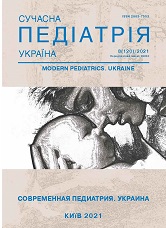Ventricular late potentials in schoolchildren with type I diabetes mellitus
DOI:
https://doi.org/10.15574/SP.2021.120.42Keywords:
type I diabetes mellitus, children, ventricular late potentials, children, ventricular late potentials, cardiac autonomic neuropathyAbstract
Purpose — to study the indicators characterizing the ventricular late potentials (VLP) in schoolchildren with type I diabetes mellitus (TIDM).
Materials and methods. 120 children aged 6–17 years were examined (56 — primary school age (6–11 years old), 64 children — senior school age (12–17 years old)). Of which at the age of 6–11 years old: 36 — with TIDM main group I, 20 healthy children (control group I). Of children 12–17 years old, 44 children were with TIDM — main group II, 20 healthy children were included in the control group II. In each age main group рatients with TIDM were divided into 2 subgroups depending on the duration of the disease: subgroup A — 39 patients (22 — primary school age, 17 — senior school age) with diabetes duration 1–3 years and subgroup B — 41 patients (14 и 27 retrospectively) with diabetes duration 4 years or more. All children underwent registration of VLP by high$resolution ECG. The following parameters were calculated: duration of the filtered QRS complex (TotORS, ms), the duration of the low$amplitude (up to 40 μV) part of the signal at the end of the QRS complex (LAS40, ms), the rms amplitude of oscillations in the last 40 ms of the ORS complex (RMS40, μV), as well as the ratio TotQRS / RMS40. The obtained results were processed on the basis of Microsoft Office Excel 2007 spreadsheets using the Statistica 7.0 package for Windows.
Results. When analyzing the indicators, it was found that children with diabetes in comparison with healthy children had differences that could be interpreted as signs of lifespan (increase in TotORS, LAS40 and TotQRS / RMS40 ratio, decrease in RMS40 values). Such changes with varying degrees of reliability were recorded in all age groups, and were more pronounced in subgroups B, both in children 6–11 years old, and in patients 12–17 years old. This speaks in favor of the aggravation of the disturbance in the electrical stability of the myocardium as the duration of the disease increases.
Conclusions. Thus, the data obtained indicate that children with type I diabetes have foci of delayed fragmented activity due to the electrophysiological heterogeneity of the myocardium. The presence of such foci is recognized as an independent prognostic factor for the risk of fatal arrhythmias, which poses the task of the specialists involved in the management of these patients with the early detection of VLP in order to prevent life$threatening conditions.
The research was carried out in accordance with the principles of the Helsinki Declaration. The study protocol was approved by the Local ethics committee of all participating institutions. The informed consent of the patient was obtained for conducting the studies.
No conflict of interest was declared by the authors.
References
Akasheva DU, Shevchenko IM, Smetnev AS et al. (1991). Use of domestic installation for registration of late ventricular potentials. Cardiology. 12: 71–74.
Alimova IL. (2016). Diabeticheskaya neyropatiya u detey i podrostkov: nereshennyie problemyi i novyie vozmozhnosti. Rossiyskiy vestnik perinatologii i pediatrii. 61 (3): 114–123. https://doi.org/10.21508/1027-4065-2016-61-3-114-123.
Berbari EJ. (1987). Critical overview of late potential recordings. J Electrocardiology. 20: 125–127.
Bobrov VA, Zharinov OI, Antonenko LN. (2011). Ventricular arrhythmias in patients with heart failure: mechanisms of occurrence, prognostic value, features of treatment. Cardiology. 4: 66–70.
Chireikin LV, Bystrov YaB, Shubik YuV. (1999). Late ventricular potentials in modern diagnosis and prognosis of the course of heart diseases. Bulletin of arrhythmology. 13: 61–74.
Dedov II, Shestakova MV. (2016). Type 1 diabetes mellitus: realities and perspectives. Moscow: Publishing Medical Information Agency.
Denes P, Santrelli P, Masson M, Uretz EF. (2013). Prevalence of late potentials in patients undergoing Holter monitoring. Amer Heart J. 113: 33–36. https://doi.org/10.1016/0002-8703(87)90006-8
ESC. (2015). 2015 ESC Guidelines for the management of patients with ventricular arrhythmias and the prevention of sudden cardiac death. European Heart Journal. 36: 2793–2867. https://doi.org/10.1093/eurheartj/ehv316; PMid:26320108
IDF. (2017). IDF Diabetes Atlas. 8th edition. Brussels: International Diabetes Federation. URL: https://www.idf.org/e-library/epidemiology-research/diabetes-atlas/134-idf-diabetes-atlas-8th-edition.html.
Pasechnaya NA. (2012). Otsenka vliyaniya strukturno-funktsionalnogo sostoyaniya miokarda na vozniknovenie pozdnih potentsialov zheludochkov pri hronicheskoy serdechnoy nedostatochnosti. Vrach-aspirant. 51 (2.2): 314–319.
Savelieva IV, Merkulova IN, Strazhesko ID et al. (2013). The relationship of late ventricular potentials with the nature of the lesion of the coronary bed and the contractile function of the left ventricle according to coronary ventriculography in patients with coronary artery disease. Cardiology. 14: 23–27.
Zaccardi F, Khan H, Laukkanen JA. (2014). Diabetes mellitus and risk of sudden cardiac death: a systematic review and meta-analysis. International Journal of Cardiology. 177 (2): 535–537. https://doi.org/10.1016/j.ijcard.2014.08.105; PMid:25189500
Downloads
Published
Issue
Section
License
Copyright (c) 2022 Paediatric surgery. Ukraine

This work is licensed under a Creative Commons Attribution-NonCommercial 4.0 International License.
The policy of the Journal “MODERN PEDIATRICS. UKRAINE” is compatible with the vast majority of funders' of open access and self-archiving policies. The journal provides immediate open access route being convinced that everyone – not only scientists - can benefit from research results, and publishes articles exclusively under open access distribution, with a Creative Commons Attribution-Noncommercial 4.0 international license (СС BY-NC).
Authors transfer the copyright to the Journal “MODERN PEDIATRICS. UKRAINE” when the manuscript is accepted for publication. Authors declare that this manuscript has not been published nor is under simultaneous consideration for publication elsewhere. After publication, the articles become freely available on-line to the public.
Readers have the right to use, distribute, and reproduce articles in any medium, provided the articles and the journal are properly cited.
The use of published materials for commercial purposes is strongly prohibited.

